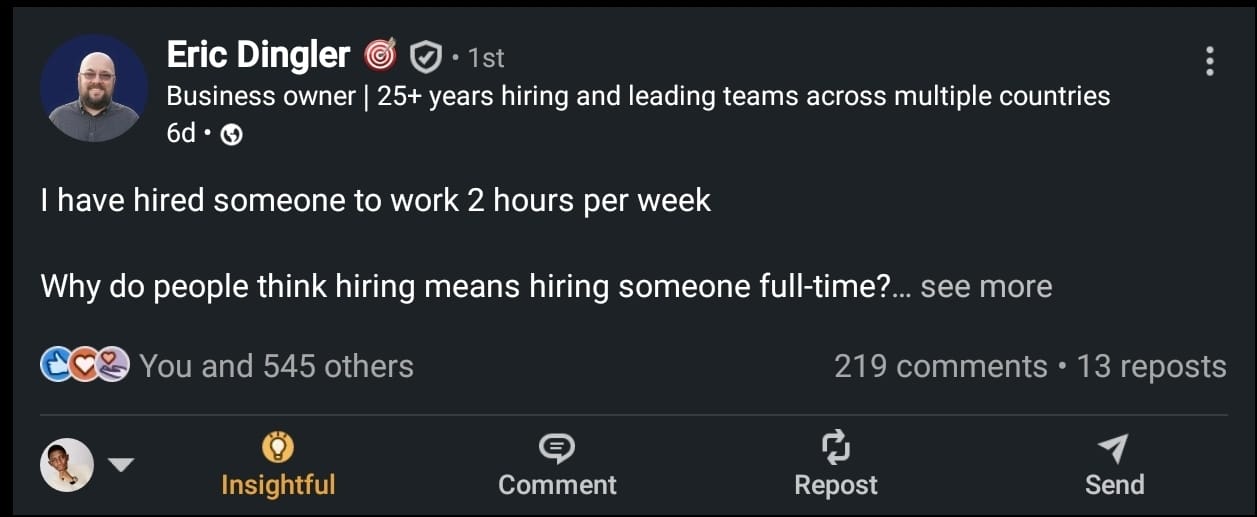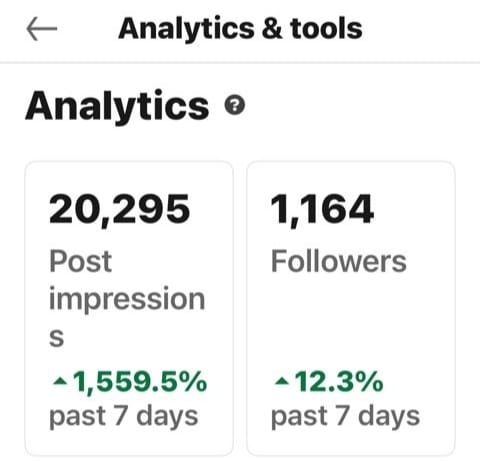- LinkedIn Famous
- Posts
- Going Viral on LinkedIn Organically is Still Possible
Going Viral on LinkedIn Organically is Still Possible
You need to see these screenshots
I am sharing 3 things with you today:
1: Proof that organic virality is still possible
2: Concessions on growing your professional network
3: Employee brand content
Let’s get into it.
I started working with a new client less than 3 weeks ago. This is someone who has 1,024 followers on LinkedIn. Had never gone viral. But I saw the potential in his profile.
He is highly experienced. And this is the main reason I started working with him.
We defined his ICP, had him go through the avatar document, and started working together. Soon enough, his posts started performing. He started getting an average of 10 reactions per post.
A few days ago, one of his posts blew up. He gained over 500 reactions on that one post.
Here is it:

LinkedIn post screenshot from Eric Dingler
Remember this is someone who has just about 1,000 followers. And it is not up to 30 days of us working together yet. He was happy to see that and I was happy too.
The impact of that viral post on his metrics looked something like this:

LinkedIn analytics screenshot from Eric Dingler
And there were no ad or promotions involved. This is 100% organic. This is just to show you that it is still possible to go viral organically on LinkedIn.
However, on my own account, I haven’t gone viral in weeks. And it is a bit intentional on my path. My goal is different. I am focused on building a strong professional network, so I have to play against some of the rules of virality.
While my metrics hasn’t been exceptional, I have been having some very incredible DM conversations. Some of which have led to interesting opportunities for me.
Let me go further on that.
Concessions on Growing Your Professional Network
To grow professional network, you have to make some concessions on the viral content framework. You stop making content to go viral and instead, you make content to connect with people – especially comments.
Here, comments are more important that posts. And this is not merely about sending or receiving a connections request.
This is about being known for your expertise such that when someone sees something that is right for you, they instantly think of you and refer you.
The most difficult thing to do here is refraining from everything that is inconsistent with your niche. Some people treat LinkedIn as Facebook and think of it as “making friends”. That is a bad idea.
You don’t want to make friends. You want to build a professional network. And you must not let what you do or your expertise be in doubt. You must be very precise and clear. All your posts and comments must reflect your core niche. Stay away from everything else.
Initially, my LinkedIn niche was remote work (and I was going viral easily). Then, I decided to focus on business and professional network. I changed my niche to marketing (which is what I do), but it was too broad and I was getting mixed results.
Later, I changed my core niche to content. Content is a subset of marketing. But it is niche enough for me. There are other core niches I tried, such as social media. But I don’t like the people I was grouped with.
Think of it this way, your core niche is what the LinkedIn algorithm uses to group you. The algorithm bundles you with other people that it assumes are like you and your posts are shown to the same people.
A very good determiner of this is your feed. Every time you change your tagline, look at your feed. If you don’t like your feed, it means that the people seeing your posts don’t like it either.
You have to ensure that you are grouped with the right people.
If you want to warm up the algorithm in this direction, go and repost the trending posts of people who speak to the same audience you want to reach. It must be a post that is less than 23 hours old, and it must be a plain repost (not “repost with your thoughts”).
Employee Brand Content
There is a growing trend of employers making their employees post content on their behalf. This is like turning the employees into a kind of influencers for the company.
One company that is doing this very exceptionally right now is Buffer.
Yes, Buffer, the social media marketing company. They are the gold standard of employee brand content right now.
I have seen content from employees of Buffer, and it is coordinated, neat, and never feels forced. Plus, employees can post whenever they like. But the Buffer post is occasional and that makes it really special.
In a lot of cases, those posts go viral. I am not sure how they coordinate it internally. But if I were to replicate that or do something better, I would coach the entire employee base of a company (who wants similar results).
I think any company serious about dominating LinkedIn should hire a Chief LinkedIn Officer. This would be the person coaching the entire workforce about the best practices of LinkedIn and then coordinate employer brand posts.
I haven’t seen any company hiring a Chief LinkedIn Officer yet, but I have started to see companies hire specialist for each social media platform (instead of hiring a social media manager to do everything).
If you run a company or you are a decision-maker in one, consider this strategy. The results would surprise you.
And that’s all for this week.
To improve your content creation, get 100K Views - contentca.teachable.com/p/100kv